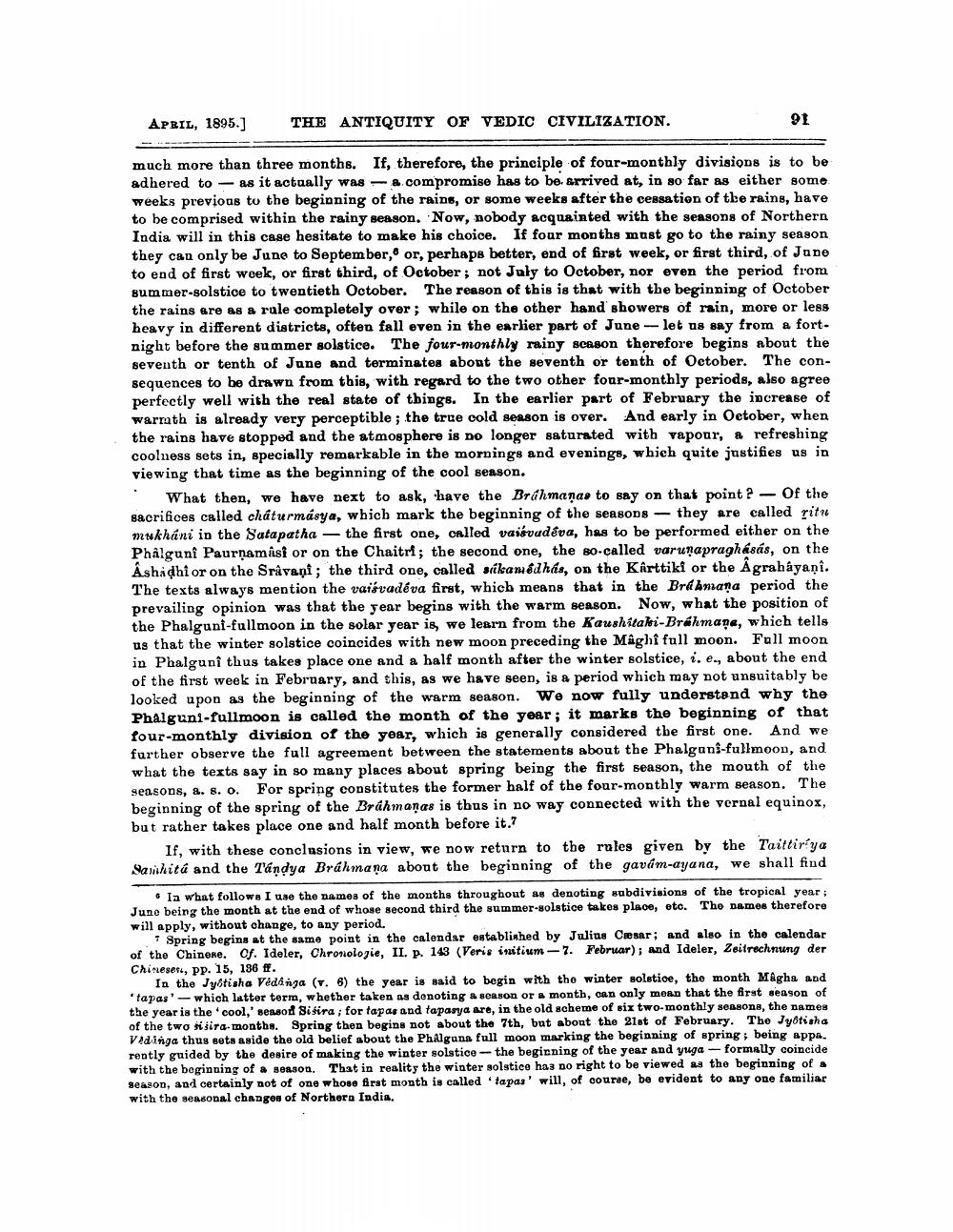________________
APRIL, 1895.]
THE ANTIQUITY OF VEDIC CIVILIZATION.
91
much more than three months. If, therefore, the principle of four-monthly divisions is to be adhered to as it actually was a compromise has to be arrived at, in so far as either some weeks previous to the beginning of the rains, or some weeks after the cessation of the rains, have to be comprised within the rainy season. Now, nobody acquainted with the seasons of Northern India will in this case hesitate to make his choice. If four months must go to the rainy season they can only be June to September, or, perhaps better, end of first week, or first third, of June to end of first week, or first third, of October; not July to October, nor even the period from summer-solstice to twentieth October. The reason of this is that with the beginning of October the rains are as a rule completely over; while on the other hand showers of rain, more or less heavy in different districts, often fall even in the earlier part of June - let us say from a fort. night before the summer solstice. The four-monthly rainy season therefore begins about the seventh or tenth of June and terminates about the seventh or tenth of October. The consequences to be drawn from this, with regard to the two other four-monthly periods, also agree perfectly well with the real state of things. In the earlier part of February the increase of warrath is already very perceptible; the true cold season is over. And early in October, when the rains have stopped and the atmosphere is no longer saturated with vapour, a refreshing coolness sets in, specially remarkable in the mornings and evenings, which quite justifies us in viewing that time as the beginning of the cool season.
What then, we have next to ask, "have the Brihmaņas to say on that point? Of the sacrifices called cháturmásya, which mark the beginning of the seasons - they are called ritu mukháni in the Satapatha - the first one, called vaisvudova, has to be performed either on the Phålguni Paurņamisi or on the Chaitri; the second one, the so-called varunapraghasás, on the Ashadhi or on the Sråvaņi; the third one, called síkanédhás, on the Karttiki or the Agrahayaņi. The texts always mention the vaisvadeva first, which means that in the Brahmana period the prevailing opinion was that the year begins with the warm season. Now, what the position of the Phalguni-fullmoon in the solar year is, we learn from the Kaushitaki-Brahmane, which tells us that the winter solstice coincides with new moon preceding the Maghi full moon. Full moon in Phalguni thus takes place one and a half month after the winter solstice, i. e., about the end of the first week in February, and this, as we have seen, is a period which may not unsuitably be looked upon as the beginning of the warm season. We now fully understand why the Phalguni-fullmoon is called the month of the year; it marks the beginning of that four-monthly division of the year, which is generally considered tbe first one. And we further observe the full agreement between the statements about the Phalgung-fullmoon, and what the texts say in so many places about spring being the first season, the mouth of the seasons, a. 8. O. For spring constitutes the former half of the four-monthly warm season. The beginning of the spring of the Brahmanas is thus in no way connected with the vernal equinox, but rather takes place one and half month before it.?
If, with these conclusions in view, we now return to the rules given by the Taittiriya Sanhita and the Tandya Brahmana about the beginning of the gavim-ayana, we shall find
• la what follows I use the names of the months throughout as denoting subdivisions of the tropical year; June being the month at the end of whose second third the summer-solstice takes place, oto. The damos therefore will apply, without change, to any period.
TSpring begins at the same point in the calendar established by Julius Caesar; and also in the calendar of the Chinese.of. Ideler, Chronologie, II. p. 143 (Veris initium-7. Februar); and Ideler, Zeitrechnung der Chineser, PP. 15, 136 ff.
In the Jyotisha Veda nga (v. 6) the year is said to begin with the winter soletioe, the month Magha and "tapas' - which latter term, whether taken as donoting & season or a month, can only mean that the first season of the year is the cool,' sensod Sifira; for tapar and tapasya are, in the old scheme of six two monthly seasons, the names of the two ti sira-months. Spring then bogins not about the 7th, but about the 21st of February. The Jyotisha Vidinga thus sets aside the old belief about the Phalgana full moon marking the beginning of spring, being apps. rently guided by the desire of making the winter solstice - the beginning of the year and yuga-formally coincide with the beginning of sonson. That in reality the winter solstice has no right to be viewed as the beginning of a season, and certainly not of one whose first month is called 'tapas' will, of course, bo evident to any one familiar with the seasonal changes of Northern India.




